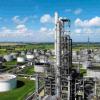Hello everyone,
I'm simulating a carbon dioxide capture process using MDEA as solvent on Aspen HYSYS V8.8 using acid gas package. My goal is to achieve 90% recovery of CO2 with following conditions that my professor specified for me:
----
<Feed gas> 50 ºC, 1.2 bar, 130,000 kmole/h
composition (mole fraction):
0.05 carbon dioxide
0.75 nitrogen
0.13 oxygen
0.07 water
<Lean amine solvent> 50 ºC, 1.2 bar, 49 wt% MDEA
lean loading (CO2 mol / MDEA mol): 0.05
<Process conditions>
Fluid package: Acid gas
Heat exchanger minimum delta T: 10 ºC
Pressure drop: 0.2 bar
CO2 product temperature: 40 ºC
Number of trays in columns (absorber / stripper): 15 / 14
Operating pressure of columns (absorber / stripper): 1.2 bar / 2.2 bar
----
As far as I understand, once you decide the L/G ratio (lean amine flowrate / feed gas flowrate), degree of freedom in this process is zero. The problem is, however, rich amine liquid from the absorber bottom has very low loading (around 0.075) when using lean amine loaded with 0.05 CO2 as the given condition. And even when L/G is as high as 20, only 50-60% of recovery is achieved.
Does anyone know why the rich amine's loading appears to be so low? It just seems like the absorber tower itself does not function well, when most of its important variables are already decided in the given condition.
Also, it was possible to close the recycle loop and achieve >90% recovery when I set the lean amine's CO2 loading as low as 0.0007 or something. But I'm supposed to use 0.05 lean loading...
Another thing is, when designing the stripper column, what kind of specs do you usually specify to make its degree of freedom zero? I've been using 0.3 reflux ratio and some random value for vent rate, however I don't think it's logical at all. When I tried specifying reboiler temperature instead of vent rate, it never converged.
Thanks for reading this lengthy post. Btw this is my bachelor's thesis project!
+ Edit: PFD screenshot from HYSYS V8.8 attached: PFD.PNG
Edited by knvrmnd, 31 May 2022 - 04:01 AM.

 FB
FB













